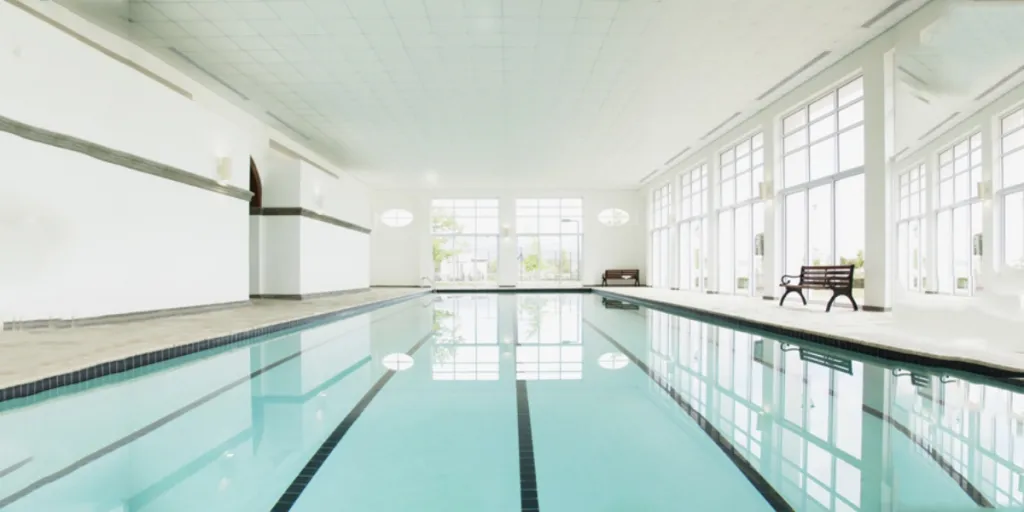The ability to maintain the best air quality in indoor pools and spas is strongly influenced by the type of dehumidifier one chooses to install. Whether you’re a professional installer, bulk reseller, or industry expert, this buyer’s guide examines which kinds of dehumidifiers are best suited to aquatic environments.
Since they’re designed to eliminate extra moisture, dehumidifiers help prevent structural damage and mold growth while maintaining user comfort. Keep reading to discover how the right indoor pool dehumidifier could revolutionize air quality control.
Table of Contents
How do indoor pool dehumidifiers work?
Perks of using indoor pool dehumidifiers
Top considerations when choosing an indoor pool dehumidifier
Conclusion
How do indoor pool dehumidifiers work?

Indoor pool dehumidifiers simply remove moisture from the air. While the dry air is reheated and then returned to the room, warm, humid air from the pool area flows over cool evaporator coils, condenses, and is collected.
Along with eliminating moisture, this method helps to preserve ideal humidity and temperature. Indoor pools have two main kinds of dehumidifiers: desiccant-based and refrigerant-based systems.
Refrigerant dehumidifiers are more common and eliminate moisture by cooling the air below its dew point using a compressor and refrigerant cycle. Conversely, desiccant dehumidifiers use a moisture-absorbing material such as silica gel to remove water vapor from the air.
Each type has its perks—desiccant systems enable exact humidity control and perform better in colder climates, while refrigerant systems are more prevalent and efficient in warmer temperatures.
Perks of using indoor pool dehumidifiers

Improved air quality
By getting rid of extra moisture from the surroundings, indoor pool dehumidifiers notably improve air quality. This decrease in moisture results in more comfortable surroundings while curbing the growth of mold, mildew, and bacteria that flourish in humid environments.
As such, it’s easy to suppress the health hazards associated with poor indoor air quality. Dehumidifiers also help to remove the musty smells sometimes found in humid pool areas.
These systems help preserve suitable chloramine levels by regulating airborne moisture, which is essential for the indoor pool’s air and water cleanliness.
Protection of structural integrity
The structural stability of indoor pool buildings depends critically on dehumidifiers’ management of humidity levels.
Installing a pool dehumidifier helps guard against rust buildup on metal components and equipment by reducing condensation on surfaces. It also lessens the deterioration of drywall, paint, and other structural materials vulnerable to moisture damage and helps stop rot in wooden buildings and furniture.
Such thorough protection dramatically increases the indoor pool’s overall lifetime. Dehumidifiers help significantly lower long-term maintenance costs by reducing moisture-related damage.
Top considerations when choosing an indoor pool dehumidifier
These pointers will be handy when picking the right dehumidifier for your indoor pool:

1. Pool size and room dimensions
Make sure the capacity of the dehumidifier you choose is appropriate for the size of your indoor pool and the space in which it will be placed. Condensation, mold, and corrosion are all symptoms of humidity that an inadequately sized dehumidifier cannot eliminate.
On the flip side, operational expenses and energy usage are worth considering if you install a large unit. Another factor to consider is the height of the room’s ceiling.
A more powerful unit is best for dehumidifying a larger air volume. Lastly, think about all the openings—windows, doors, etc.—because they influence the total humidity load.
2. Climate and humidity levels
Dehumidifier efficiency is highly dependent on ambient temperature and humidity. Choose a dehumidifier designed for high-humidity locations to ensure a comfortable and safe environment. A modest-capacity unit will work harder in such areas.
Don’t forget to factor in seasonal changes; for example, in coastal regions or during rainy seasons, the unit could have to handle much greater moisture levels.
When choosing a dehumidifier, it’s helpful to know how the dew point relates to the room’s temperature and the outside temperature so that the humidity may be controlled all year round.
3. Drying method
Although more widespread and efficient, dehumidifiers running on refrigeration might not perform as well in colder climates.
Desiccant dehumidifiers are perfect for places where noise is a problem because of their reduced noise production and capacity to operate over a wide temperature range.
Some units include heat pump technology, which reuses the heat generated during dehumidification to provide an even more remarkable energy economy. You want to weigh the perks and downsides of every unit you are considering.
4. Pint capacity
A key metric for determining if the dehumidifier can manage the humidity load in the room is its pint capacity, which is the amount of moisture it can remove from the air in one day.
Considerations like pool size, room dimensions, and local climate will determine the required pint capacity. To avoid underperformance, you have to choose the correct pint capacity. Since bigger units often use more energy, it can also be costly to overestimate needs.
In commercial and industrial environments, choosing a unit with adaptable speed settings or pint capacity is more efficient and can be adjusted depending on the current humidity levels.
5. Energy consumption

As a professional buyer, you want to know a dehumidifier’s capacity levels, humidity requirements, and energy consumption before purchasing one. Dehumidifiers are categorized according to their capacity to remove moisture in 24 hours, usually expressed in pints.
Models with a smaller capacity (20-30 pints/day) are ideal for smaller rooms with moderate humidity, like bedrooms or offices. Large-capacity dehumidifiers (50+ pints/day) are useful for places like indoor pools or commercial areas with excessive moisture.
In contrast, medium-capacity units (30-50 pints/day) are ideal for basements or bigger regions with increased humidity. The size of the room and the relative humidity will determine the best dehumidifier to use. A smaller capacity device might be enough for moderate humidity conditions (50-60%).
Having said that, a medium-capacity unit is more appropriate for places with greater humidity (60-70%), and an indoor pool or other space with extremely high humidity (70%+) does not allow for comfortable or mold-free conditions.
Energy usage is an additional important consideration. Power consumption for high-capacity devices usually exceeds 900 watts. You can save money on energy bills by choosing models certified by Energy Star.
These models remove more moisture per kilowatt-hour. A higher Energy Factor (EF) rating indicates greater efficiency and long-term savings, so be sure to check it out.
6. Voltage and rating
The dehumidifier must be compatible with the power grid in commercial and industrial settings. Choosing the wrong voltage rating might lead to electrical issues or reduced performance.
Units with a higher voltage, such as 208V or 240V, are standard to accommodate the higher power demands of industrial or large-scale installations. Before purchasing this item, research its amperage requirements so your electrical system can manage them without overloading circuits.
If the voltage and rating are compatible with the site’s electrical capacity, operational problems and safety risks can be easily avoided.
7. Installation and maintenance
Given that the unit needs integration with either specialized ducting or current HVAC systems, look at the installation process’s complexity. You might consider professional installation to ensure the system runs effectively and accurately.
Another essential factor is maintenance—easily reachable components for regular cleaning and filter changes will save time and lower downtime. Consider the availability of replacement components and whether the manufacturer provides consistent technical support.
Tips for Industrial use
A commercial-grade dehumidifier is absolutely necessary for large-scale projects. These units are superior to residential alternatives in capacity, performance, and longevity because they are designed to endure heavy use.
Industrial dehumidifiers typically have a built-in humidistat for precise control, a state-of-the-art filtering system to maintain good air quality, and the capacity to run constantly. Consider how well the device integrates with your present building management system (BMS) for unified monitoring and control.
Reliability, ease of maintenance, and manufacturer support are other important factors for industrial use that impact operational success in the long term.
Conclusion
The right indoor pool or spa dehumidifier achieves optimal air quality, structural integrity, and energy economy. This guide can help anyone, be it an installer, professional, or wholesaler, make an informed choice.
A dehumidifier is a worthwhile investment to increase comfort and safeguard your building. Alibaba.com offers a wide selection of indoor pool dehumidifiers to suit the needs of clients with diverse demands and budgets. Compare various options to verify that their offerings are suitable for your project.




